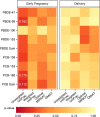Associations of prenatal exposure to polybrominated diphenyl ethers and polychlorinated biphenyls with long-term gut microbiome structure: a pilot study
- PMID: 30778401
- PMCID: PMC6376400
- DOI: 10.1097/EE9.0000000000000039
Associations of prenatal exposure to polybrominated diphenyl ethers and polychlorinated biphenyls with long-term gut microbiome structure: a pilot study
Abstract
Background: The gut microbiome is influenced by early-life exposures, but-despite potentially enormous implications for child health-is understudied in environmental epidemiology. This pilot study is one of the first to explore in utero exposures and long-term gut microbiome profiles. We examined the association between exposure to polybrominated diphenyl ethers (PBDEs) and polychlorinated biphenyls (PCBs) during pregnancy and the mid-childhood gut microbiome.
Methods: We measured levels of PBDE-47, -99, -100, and -153 and PCB-138, -153, and -180 in maternal plasma during early pregnancy (n=18) and at delivery (n=25) in women of European descent who breastfed the child participant of the Gestation and Environment cohort in Sherbrooke, Québec (recruited 2007-2009). Bacteria in the mid-childhood (6-8 years) fecal microbiome were detected with 16S rRNA sequencing. To test for differences at the taxon level, we used the Microbiome Comprehensive Association Mapping algorithm.
Results: Early pregnancy PCB-153, -180, and the sum of PCBs (Σ3PCB) concentrations were associated with a higher relative abundance of Propionibacteriales and Propionibacteriaceae in mid-childhood. Higher PCB-180 and Σ3PCB were associated with higher relative abundance of Bacillales Family XI. Higher PBDE-99 exposure was associated with a decrease in uncultured bacteria within the Ruminococcaceae NK4A214 group and PBDE-47 was associated with differences in Ruminococcus 2. These taxon-level changes did not result in differences in within- or between-subject diversity. Exposures at delivery were not associated with differences in taxa.
Conclusions: Prenatal exposure to PCBs and PBDEs is associated with mid-childhood gut microbiome profiles. Larger studies are needed to confirm these results and explore health implications.
Conflict of interest statement
Declaration of competing financial interests: The authors declare they have no actual or potential competing financial interests.
Figures




References
Grants and funding
LinkOut - more resources
Full Text Sources
